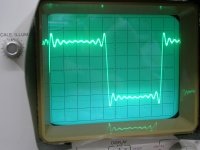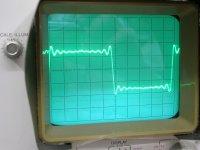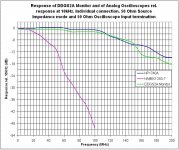No. Richard said "Dull" and "Lifeless". Not exactly the same thing. Sound more related with micro dynamic than tonal balance. You can add as much trebles you like to a dead body, it not bring-it to life.I think that you've recently rather clearly stated your biases in this matter - you admitted that all CD players sound rolled off to you.
Last edited:
I think that you've recently rather clearly stated your biases in this matter - you admitted that all CD players sound rolled off to you.
What to do with all the audiophiles who claim that CD players sound harsh to them which usually means that they have too much treble?
What do to with all of the carefully done listening tests that show that a good CD player does neither, but provides an excellent rendition of the signal that is on the CD?
Well, how can I compare to what others listen to/with and what I do? Maybe fortunately, I do not subscribe to those magazines. Those I check them now and then for what the newest products are doing.
Harsh means to ME, distortion is there. Now a high peak at treble can cause similar harsh sound... due to increased distortion... either being greater in amplitude or overload/drive behavour along their system path.
I use masters that I made myself... so i know what it is supposed to sound like and also that CD is very far from master tapes. When I wanted to know how a phono stage sounded like, I ran the master thru an inverse RIAA and listened. Maybe some listeners havent done this to learn real from reproduced? I dont know. My bias as you think they are is based on a lot of tests and listening and comparing etc. Not on what a lot of others think or listen to or magazine reviews.
If you note too my little filter rises above 10KHz... that extends the flat freq response higher up... not a very perfect fit but for a quicky... satisfying direction for further improvement. IMO.
A good opamp design that makes a good conjugate match will be the final solution. But, why bother when we can have direct master downloads of 24/96+?? Many problems solved and it sounds great.
Bias? Not really that much.
THx-RNMarsh
Last edited:
But, why bother when we can have direct master downloads of 24/96+?? Many problems solved and it sounds great.
THx-RNMarsh
You are assuming that 24/96 is somehow closer to the 'signed off' recording than 16/44.1 . Is that really a valid assumption?
One thing that glares out to me ........ :
You guys need good 'ol analog scopes !
Michael
I burned on a CDR disk Pavel’s 1102.5Hz SQRW –2.5dB FS (see post #76930) and I played it on an old Philips CD 151(TDA1540+SAA7030 4x oversampling + post DAC 3rd order analog filter identical to the one posted in post#76934 only with LM833 in place of NE5532).
First two attachments are screenshots from a HP 1740A, (100MHz BW) connected to the analog out of the CD player playing Pavel’s SQRW
Third attachment is the spectrum of the CD player’s output while playing this track.
Forth attachment is same CD player playing a 1kHz SQRW –6dB FS generated through Wavelab at 44.1k/16bits. This shows a bit more extended BW (21 harmonics) compared to Pavel’s (19 harmonics) .
's perceptions are largely illusory
Arnold, you are entitled to your opinion but you wouldn’t turn so personal here, it won’t help anybody.
George
Attachments
You are assuming that 24/96 is somehow closer to the 'signed off' recording than 16/44.1 . Is that really a valid assumption?
yes.
Last edited:
George ............................ Nice scope !
I've toyed with digital scopes myself .
They're so nice and compact .
And I don't think it takes long to adjust ones perceptions.
But for real intense wave inspection ?
I wouldn't want to try to set AB bias with one .
I now have a $150 SinoMeter that does way better
than most digital ( for my purposes )
Then there's the thought that if digital cannot render
a picture of a signal, how can it render the sound ?
( the ears being way more sensitive than the eyes )
I've toyed with digital scopes myself .
They're so nice and compact .
And I don't think it takes long to adjust ones perceptions.
But for real intense wave inspection ?
I wouldn't want to try to set AB bias with one .
I now have a $150 SinoMeter that does way better
than most digital ( for my purposes )
Then there's the thought that if digital cannot render
a picture of a signal, how can it render the sound ?
( the ears being way more sensitive than the eyes )
To lighten the mood. Had one of those 'wife in kichen' type moments earlier. A pixar movie was on and after the credits the disney logo appears (as per attached jpg)
Currently bedding in a (new to me) amplifier so on edge listening for anything going amiss but wasn't watching the screen. suddenly pick on a strange fluttering noise and look up worried that something is going unstable in the amp. Nope, the disney logo has fluttering flags and someone had got the Foley artists to add some flutter noise. Had never noticed that before and, having kids have watched a lot of pixar movies!
Now I could wax lyrical on how amazing this amplifier is, but I have to be honest, since this amplifiers brother had an output stage burn out last week (nice flames and all) I am being extra careful with this one till I am sure it works. Just sometimes a hair trigger protection circuit is useful 🙂
And yes sometimes I like to live dangerously.
Currently bedding in a (new to me) amplifier so on edge listening for anything going amiss but wasn't watching the screen. suddenly pick on a strange fluttering noise and look up worried that something is going unstable in the amp. Nope, the disney logo has fluttering flags and someone had got the Foley artists to add some flutter noise. Had never noticed that before and, having kids have watched a lot of pixar movies!
Now I could wax lyrical on how amazing this amplifier is, but I have to be honest, since this amplifiers brother had an output stage burn out last week (nice flames and all) I am being extra careful with this one till I am sure it works. Just sometimes a hair trigger protection circuit is useful 🙂
And yes sometimes I like to live dangerously.
yes.
Is there any actual evidence of this? Other than the marketing mind f*** of the companies trying to sell you the HD downloads.
... played it on an old Philips CD 151(TDA1540+SAA7030 4x oversampling + post DAC 3rd order analog filter....
..............
Third attachment is the spectrum of the CD player’s output while playing this track.
..............
George, while you're at it, can you play some full scale sine signal on that old beast and post a picture of output spectrum (including noise) up to, say, 1MHz?
Thanks,
To lighten the mood. Had one of those 'wife in kichen' type moments earlier. A pixar movie was on and after the credits the disney logo appears (as per attached jpg)
Currently bedding in a (new to me) amplifier so on edge listening for anything going amiss but wasn't watching the screen. suddenly pick on a strange fluttering noise and look up worried that something is going unstable in the amp. Nope, the disney logo has fluttering flags and someone had got the Foley artists to add some flutter noise. Had never noticed that before and, having kids have watched a lot of pixar movies!
Now I could wax lyrical on how amazing this amplifier is, but I have to be honest, since this amplifiers brother had an output stage burn out last week (nice flames and all) I am being extra careful with this one till I am sure it works. Just sometimes a hair trigger protection circuit is useful 🙂
And yes sometimes I like to live dangerously.
Are you going to share some pictures (of the amplifier, not the flames) and some circuits?
I strongly recommend that everyone interested in audio reproduction seriously look at the Heyser Lecture by John Atkinson in 2011. John is RIGHT ON! I know that this point-of-view is criticized by many 'critics' here, but it is what I have found that makes audio works better and better.
I first met Richard Heyser in 1968 (a very good year) at the AES and we became fast friends. He changed my life as an audio design engineer.
Subjective reality - It's clear most folks hear things differently to others which is all well and good otherwise we'd treat audio products as completely utilitarian - y'know, just like hyperdermic syringes for example. One size fits all.
Objective Fantasy - However, that does not negate scientific methods findings that in reality there may be little or no differences - whether JA likes it or not (and BTW I do respect his approach enormously).
I strongly recommend that everyone interested in audio reproduction seriously look at the Heyser Lecture by John Atkinson in 2011. John is RIGHT ON! .
He starts out with one of the most common and worst analogies around, taking the real part of the solution when using complex algebra is like throwing something away. To think this is freshman algebra, or at least used to be.
George ............................ Nice scope !
I've toyed with digital scopes myself .
Michael it’s a beauty, I agree.
I am tempted to get a DSO myself for what they offer but I can’t stand the 8 bit vertical resolution and I can’t afford the price of the 12 bit DSOs. So I suppress the idea for the future.
I also don’t know how they behave close to the limit of their bandwidth.
See how the same SQRW of Pavel is shown on the screen of a 20MHz BW Hameg HM203-7 (and it’s not malfunctioning)
ElektrojGeorge, while you're at it,
I will try to do it tomorrow.
1kHz sine is OK or you’d like another frequency?
George
Attachments
The amplifier is the 1997 Stochino design that was published in wireless world. Forum member AlexM was having a clearout and gave me a few projects that he was no longer using. As I am midway through the active conversion of my system but short on time and money with the baby. So I sifted through and used the first amp in the stash that worked. That died so now the second amp in the stash that worked is in 🙂
http://www.southampton.ac.uk/~apm3/diyaudio/Stochino_circuit.jpg is roughly the circuit but with different output devices. A few things need changing on it, but they will have to wait as the project backlog is a bit long. For now its hum free and plays music. Makes me realise how close to death my old counterpoint was. Given the right hand apogee is playing through the xmas tree no point doing critical listening until new year 🙂
http://www.southampton.ac.uk/~apm3/diyaudio/Stochino_circuit.jpg is roughly the circuit but with different output devices. A few things need changing on it, but they will have to wait as the project backlog is a bit long. For now its hum free and plays music. Makes me realise how close to death my old counterpoint was. Given the right hand apogee is playing through the xmas tree no point doing critical listening until new year 🙂
Is there any actual evidence of this? Other than the marketing mind f*** of the companies trying to sell you the HD downloads.
yes
Elektroj
I will try to do it tomorrow.
1kHz sine is OK or you’d like another frequency?
George
Thank you, George! Any sine will do. It would be just interesting (and educational) to see how the HF 'garbage' of multi bit DAC looks in comparision to sigma-delta type(s) shown previously.
would you care to share this evidence?
Wish in one hand and s**t in the other and see which one fills up first.
As a side comment the level of technical input here from some quarters has become an embarrassment.
Last edited:
- Status
- Not open for further replies.
- Home
- Member Areas
- The Lounge
- John Curl's Blowtorch preamplifier part II






